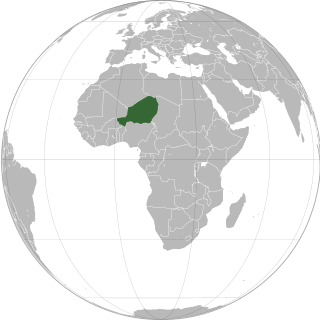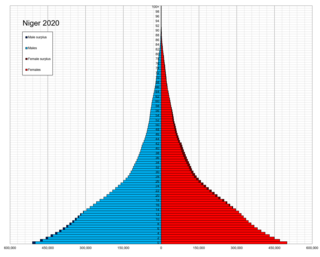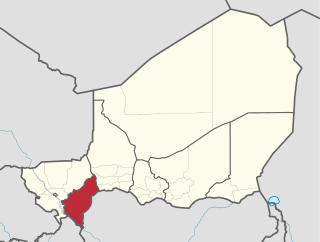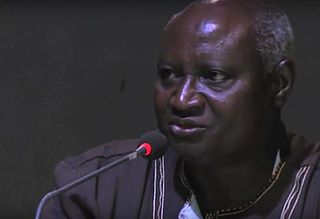Related Research Articles

Niger or the Niger, officially the Republic of the Niger, is a landlocked country in West Africa. It is a unitary state bordered by Libya to the northeast, Chad to the east, Nigeria to the south, Benin and Burkina Faso to the southwest, Mali to the west, and Algeria to the northwest. It covers a land area of almost 1,270,000 km2 (490,000 sq mi), making it the largest landlocked country in West Africa. Over 80% of its land area lies in the Sahara. Its predominantly Muslim population of about 25 million live mostly in clusters in the south and west of the country. The capital Niamey is located in Niger's southwest corner.

Demographic features of Nigeriens, the people of Niger, include population density, ethnicity, education level, health of the populace, economic status, religious affiliations and other aspects of the population.

The music of Niger has developed from the musical traditions of a mix of ethnic groups; Hausa, the Zarma-Songhai, Tuareg, Fula Kanuri, Toubou, Diffa Arabs and Gurma and the Boudouma from Lac Chad.

Jean Rouch was a French filmmaker and anthropologist.

Zarma is one of the Songhay languages. It is the leading indigenous language of the southwestern lobe of the West African nation of Niger, where the Niger River flows and the capital city, Niamey, is located. Zarma is the second-most common language in the country, after Hausa, which is spoken in south-central Niger. With over 4 million speakers, Zarma is easily the most widely spoken Songhay language.

The Songhai people are an ethnolinguistic group in West Africa who speak the various Songhai languages. Their history and lingua franca are linked to the Songhai Empire which dominated the western Sahel in the 15th and 16th century. Predominantly a Muslim community, the Songhai are found primarily throughout Niger and Mali in the Western sudanic region. The name Songhai was historically neither an ethnic nor linguistic designation, but a name for the ruling caste of the Songhay Empire which are the Songhai proper of sunni and Askya dynasty found predominantly in present-Niger. However, the correct term used to refer to this group of people collectively by the natives is "Ayneha". Although some Speakers in Mali have also adopted the name Songhay as an ethnic designation, other Songhay-speaking groups identify themselves by other ethnic terms such as Zarma or Isawaghen. The dialect of Koyraboro Senni spoken in Gao is unintelligible to speakers of the Zarma dialect of Niger, according to at least one report. The Songhay languages are commonly taken to be Nilo-Saharan. Dimmendaal (2008) believes that for now it is best considered an independent language family.

Dosso is one of the eight Regions of Niger. The region has an area of 31,002 square kilometres (11,970 sq mi), with a population of 2,078,339 as of 2011.

The Zarma people are an ethnic group predominantly found in westernmost Niger. They are also found in significant numbers in the adjacent areas of Nigeria and Benin, along with smaller numbers in Burkina Faso, Ivory Coast, Ghana, Togo, and Sudan. In Niger, the Zarma are often considered by outsiders to be of the same ethnicity as the neighboring Songhai proper, although the two groups claim differences, having different histories and speaking different dialects. They are sometimes lumped together as the Zarma-Songhay or Songhay-Zarma.

Ouallam is a department of the Tillabéri Region in Niger. Its capital lies at the city of Oullam, which is designated an Urban Commune. The department also includes the Rural Communes of Simiri and Tondikiwindi, as well as the towns of Bani Bangou and Dingazi. As of 2011, the department had a total population of 383,632 people.

Téra is a department of the Tillabéri Region in Niger. Its capital lies at the city of Téra. As of 2011, the department had a total population of 579,658 people.
The Kurtey people are a small ethnic group found along the Niger River valley in parts of the West African nations of Niger, Benin, Mali, and Nigeria. They are also found in considerable numbers in Ghana, Togo, Ivory Coast, and Burkina Faso.
Télé Sahel is the national broadcaster of the West African state of Niger. Owned and operated by the government Office of Radio and Television of Niger, which also operates Radio Voix du Sahel and the TAL TV satellite station, Télé Sahel provides news and other programs in French and several local languages. Its stations transmit to all urban centers. Founded in 1964, its current Director General is Moussa Saley.

Hamdallaye is a village and rural commune in Niger. In 2012, it had a registered population of 57,002 inhabitants. It is located in the southwest of the country, near the Niger River, the border with Mali and Burkina Faso and the national capital, Niamey. It is the location of a U.S. Peace Corps training site, a weekly market and a mosque.

Adamou Idé is a Nigerien poet and novelist.

Songhoyboro Ciine or Songhay Ciiné is an upriver dialect of the southern Songhay dialect of Niger. It is spoken mostly in the northwestern corner of Niger's Tillaberi region, an area known as Songhay: from Gorouol, a border town with Mali, down to the towns of Tera, Anzourou, Namari Goungou and Say.

The Islamic State Sahel Province (ISSP), formerly known as Islamic State in the Greater Sahara (IS-GS), is an Islamist militant group adhering to the ideology of Salafi Jihadism. IS-GS was formed on 15 May 2015 as the result of a split within the militant group Al-Mourabitoun. The rift was a reaction to the adherence of one of its leaders, Adnan Abu Walid al-Sahraoui, to the Islamic State. From March 2019 to 2022, IS-GS was formally part of the Islamic State – West Africa Province (ISWAP); when it was also called "ISWAP-Greater Sahara". In March 2022, IS declared the province autonomous, separating it from its West Africa Province and naming it Islamic State Sahel Province (ISSP).

Les Filles de Illighadad are a Tuareg band founded by Fatou Seidi Ghali in Illighadad, a village in the Sahara Desert in Niger. Ghali, it is claimed, is the first Tuareg woman to play guitar professionally.
Mali Bero or Zarmakoy Sombo is a mythical legendary leader of the Zarma people of western Niger who led them in their migration from an unknown region in Mali eastward to western Niger several centuries ago. The story of Mali Bero has appeared in various forms in the Zarma society from poems, songs and oral narratives by griots. No one, however, has published a linear version of the story of Mali Bero that is more than a few hundred lines long. Mali Bero, however, is believed to be the son of Zabarkane, another Zarma legendary figure
The Wogo people are a small subgroup of the broader Songhai people. They are found primarily in Niger and Mali on the banks and islands of the Niger river, a territory they share with the Zarma, the Kurtey and the Songhay. The main Wogo communities are found on the islands in the Tillabery region of Niger with the largest being Ayorou in Niger and Boura in Mali. They speak the Wogo Ciine songhay dialect.

The Songhai proper are an ethnic group in the northwestern corner of Niger's Tillaberi Region, an area historically known in the country as Songhai. They are a subgroup of the broader Songhai group. Even though the Songhais have so much in common with the Zarma, to the extent that some Songhais may refer to themselves and their dialect as "Zarma", both see themselves as two distinct branches of the same ethnicity.
References
- ↑ Aziz, Tony (2014), Zarma Bitti (Niger, 2017), norient.com, retrieved 2021-12-08
- ↑ Bitti Harey : L'âme De La Culture Du Zarmaganda Sans Relève, Le Sahel, 2019, retrieved 2021-12-08
- ↑ B, SURUGUE (1972), CONTRIBUTION A L'ETUDE de la MUSIQUE SACREE ZARMA SONGHAY (PDF), retrieved 2021-12-08
- ↑ DeValve, John R (2017), Singing Foreign Songs in the Lord's House: An Examination of the Worship Music Sung in Songhai/Zarma Protestant Churches of the West African Sahel, with Special Reference to Niger (PDF), Middlesex University Research Repository, p. 196, retrieved 2021-12-08
{{citation}}: CS1 maint: location missing publisher (link)